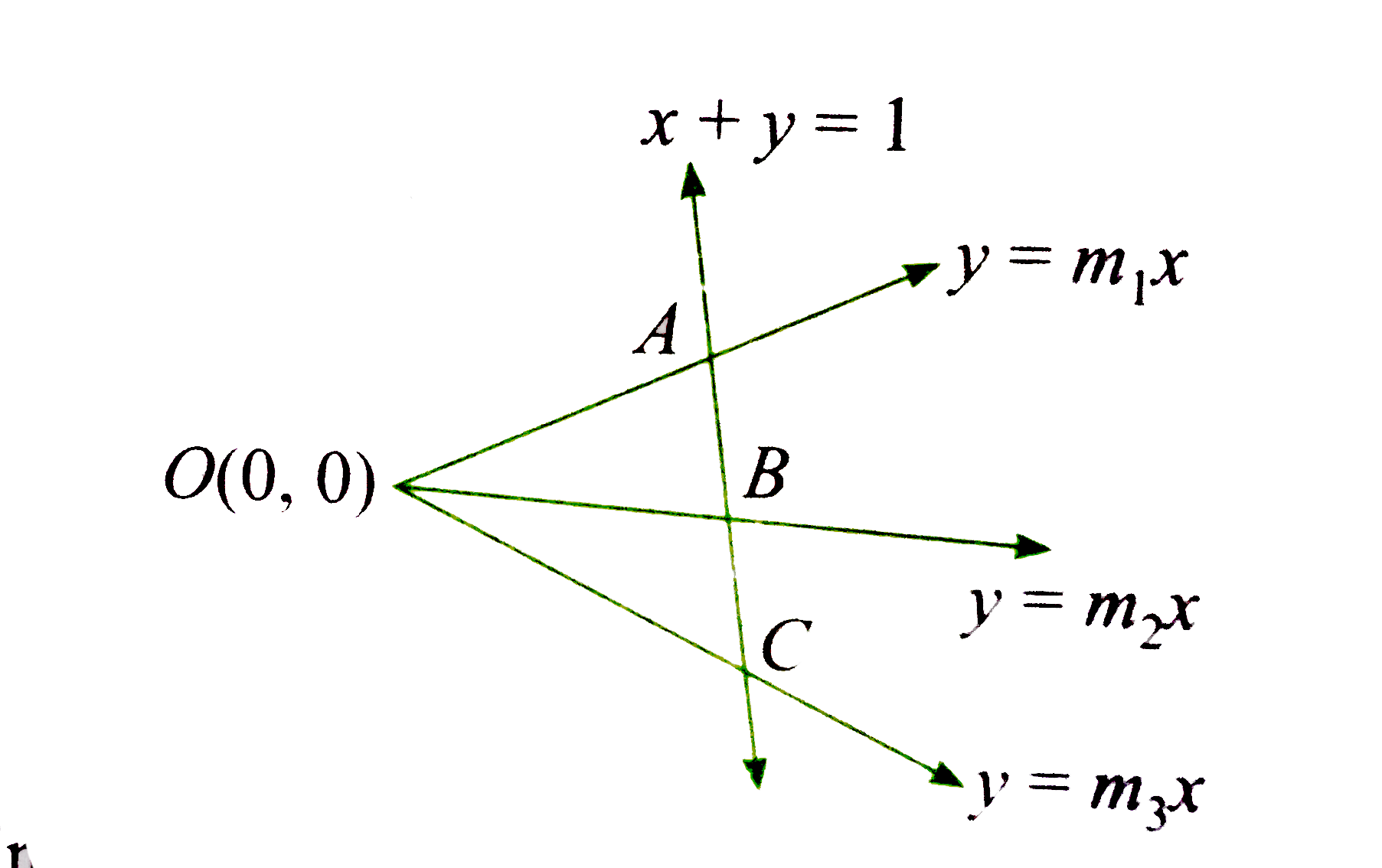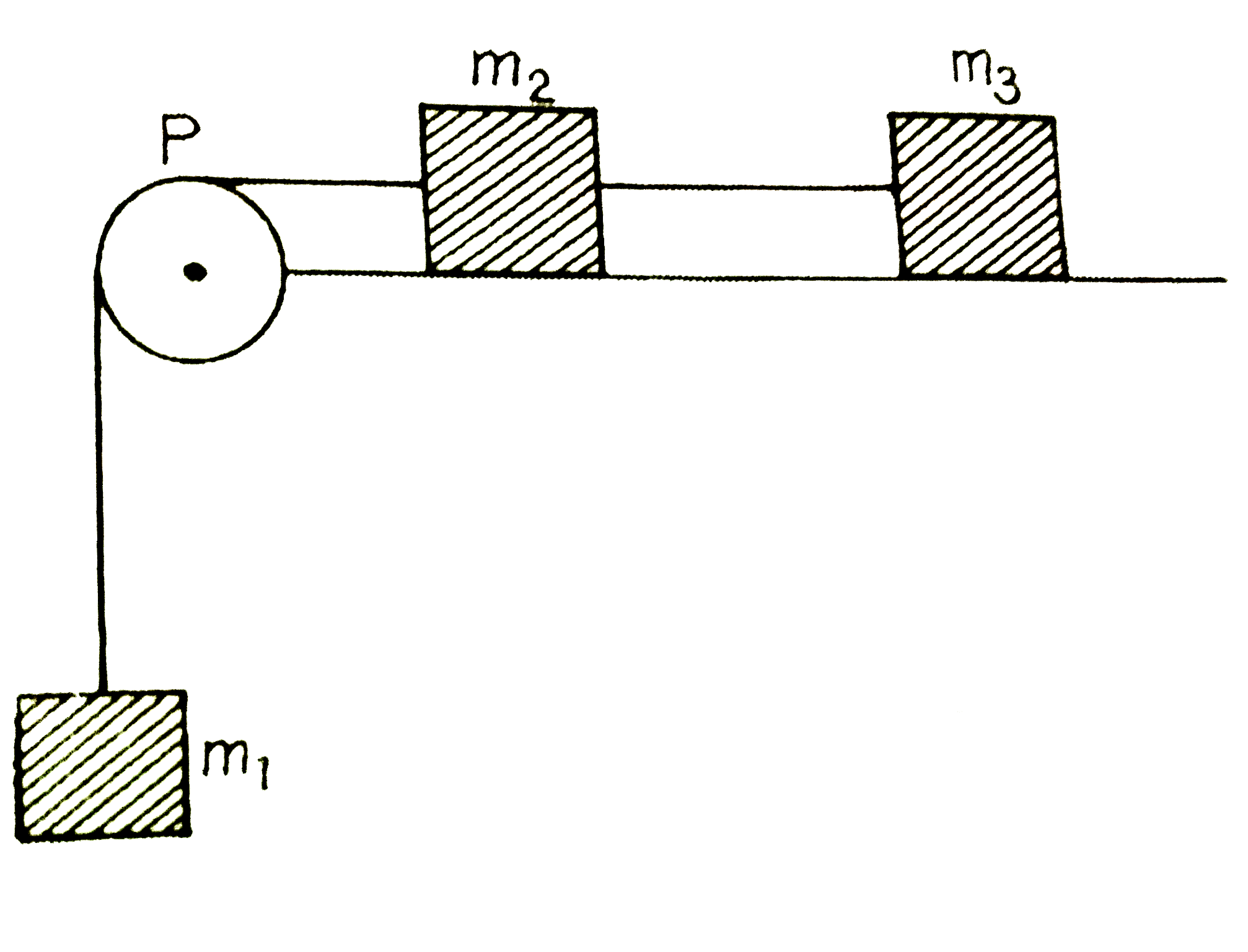The lines y=m1x,y=m2xandy=m3x make equal intercepts on the line x+y=1. Then 2(1+m1)(1+m3)=(1+m2)(2+m1+m3) (1+m1)(1+m3)=(1+m2)(1+m1+m3) (1+m1)(1+m2)=(1+m3)(2+m1+m3) 2(1+m1)(1+m3)=(1+m2)(1+m1+m3)Solution in Tamil
2(1+m1)(1+m3)=(1+m2)(2+m1+m3)
(1+m1)(1+m3)=(1+m2)(1+m1+m3)
(1+m1)(1+m2)=(1+m3)(2+m1+m3)
2(1+m1)(1+m3)=(1+m2)(1+m1+m3)
The correct Answer is:A

Solving the equations of the lines, we get
A≡(11+m1,m11+m1),C≡(11+m3,m31+m3)
If AB=BC, then the midpoint of AC lies on
y=m2x
or m11+m1+m31+m32=m2⎡⎢⎣11+m1+11+m32⎤⎥⎦
Topper's Solved these Questions
- STRAIGHT LINESBOOK - CENGAGECHAPTER - STRAIGHT LINESEXERCISE - Exercise (Multiple)
30 Videos
- STRAIGHT LINESBOOK - CENGAGECHAPTER - STRAIGHT LINESEXERCISE - Exercise (Comprehension)
27 Videos
- STRAIGHT LINESBOOK - CENGAGECHAPTER - STRAIGHT LINESEXERCISE - Exercise 2.6
5 Videos
- STRAIGHT LINEBOOK - CENGAGECHAPTER - STRAIGHT LINEEXERCISE - Multiple Correct Answers Type
8 Videos
- THEORY OF EQUATIONSBOOK - CENGAGECHAPTER - THEORY OF EQUATIONSEXERCISE - JEE Advanced Previous Year
9 Videos
Similar Questions
If P is a point (x,y) on the line y=−3x such that P and the point (3, 4) are on the opposite sides of the line 3x−4y=8, then x>815 (b) x>85 y<−85 (d) y<−815
View SolutionLet L be the line belonging to the family of straight lines (a+2b) x+(a-3b)y+a-8b =0, a, b ∈R, which is the farthest from the point (2, 2).
Area enclosed by the line L and the coordinate axes is
View SolutionIf aandb are two arbitrary constants, then prove that the straight line (a−2b)x+(a+3b)y+3a+4b=0 will pass through a fixed point. Find that point.
View SolutionThe point P(α,α+1) will lie inside the triangle whose vertices are A(0,3),B(−2,0) and C(6,1) if
View SolutionQ. Let p and q real number such that p≠0,p2≠q and p2≠−q. if α and β are non-zero complex number satisfying α+β=−p and α3+β3=q, then a quadratic equation having αβ and βα as its roots is
View SolutionIf l_1^2+m_1^2+n_1^2=1 etc., and l_1 l_2+m_1 m_2+n_1 n_2 = 0, etc. and Delta=|(l_1,m_1,n_1),(l_2,m_2,n_2),(l_3,m_3,n_3)| then
View SolutionProve that a point can be found which is at the same distance from each of the four points :(a m_1, a/(m_1))*(a m_2, a/(m_2))*(a m_3, a/(m_3))"and"(a/(m_1m_2 m_3), a m_1m_2m_3)
View SolutionIf the lines whose equations are y=m1x+c1,y=m2x+c2andy=m3x+c3 meet in a point, then prove that : m1(c2−c3)+m2(c3−c1)+m3(c1−c2)=0
View SolutionIf (mi,1mi) , i = 1, 2, 3, 4 are concyclic points, then the value of m1m2m3m4 is :
View Solutionm1,m2 व m3 द्रव्यमान के तीन पिण्ड क्रमागत द्रव्यमान रहित डोरी से जुड़े हैं और एक घर्षण रहित मेज पर रखे हैं | यदि m3 द्रव्यमान को बल F से खींचा जाए, तो m2 व m3 द्रव्यमानों के बीच डोरी में तनाव होगा :
View Solutionयहाँ दर्शाये गये निकाय में तीन पिंड m1,m2 और m3 एक रस्सी से जुड़े है जो एक घिरनी के ऊपर से होकर गुजरती है। m1 मुक्त रूप से लटका है औरm2 तथा m3 एक रुक्ष क्षैतिज मेज पर है, जिसका घर्षण गुणांक =μ है। घिरनी घर्षणरहित है और इसका द्रव्यमान नगण्य है। यदि m1=m2=m3=m है, तो m1 का अधोमुखी (नीचे की ओर) त्वरण होगा:

View SolutionIf l21+m21+n21=1 etc., and l1l2+m1m2+n1n2=0, etc. and Δ=∣∣ ∣∣l1m1n1l2m2n2l3m3n3∣∣ ∣∣ then
View SolutionThe lines y=m1x,y=m2xandy=m3x make equal intercepts on the line x+y=1. Then (a) 2(1+m1)(1+m3)=(1+m2)(2+m1+m3) (b)(1+m1)(1+m3)=(1+m2)(1+m1+m3) (c)(1+m1)(1+m2)=(1+m3)(2+m1+m3) (d)2(1+m1)(1+m3)=(1+m2)(1+m1+m3)
View SolutionGravitational force between masses m_1 and m_2 is F. If a third mass m_3 is placed near m_2 and m_3 then the force between m_1 and m_2 would be
View SolutionIf three lines whose equations are y =m_1 x+c_1, y=m_2 x+c_2 and y=m_3 x+c_3 are concurrent, then show that m_1(c_2-c_3)+m_2(c_3-c_1)+m_3(c_1-c_2)=0
View SolutionIf the lines whose equations are y=m1x+c1,y=m2x+c2andy=m3x+c3 meet in a point, then prove that : m1(c2−c3)+m2(c3−c1)+m3(c1−c2)=0
View Solution
